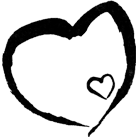Everything is connected to everything
Fascia is a web material throughout the body, forming wrappers and slings for every organ and every muscle. Your heart is suspended in the chamber of your ribs. Your uterus is suspended in your pelvic by a fascia hammock connected to the bones. Each muscle in your back, small or large, has wrappers and connectors.
Wrappers & slings
In the great internal web, each wrapper & sling is connected to adjacent wrappers and slings. Just like a suspension bridge, when bones are in good alignment and muscles are well toned in full range, everything functions in balance. But if bones are out of alignment, then soft tissues of muscles and fascia are pulled out of place. And it goes both ways. If muscles and fascia are either (1) tight and short or (2) lax and stretched out, then these soft tissue imbalances can pull bones out of alignment.
Connections are specific
Just as muscle can be pulled/pushed out of alignment, fascia can be affected by specific high impact events or by chronic repetitive use patterns. Muscles and fascia can get out of alignment when we are born or giving birth, with a fall off a bike or skis, or by prolonged daily activities like sitting at a desk with poor posture or repetitive use of our bodies, as for carpenters, musicians and cashiers.
Muscles and fascia together are called the myofascial system. They function together to hold everything in place  dynamically, rather than in fixed or rigid relationships.
dynamically, rather than in fixed or rigid relationships.
Membranes and mini-tramps
Fascia comes in various degrees of density. The thinnest, light fascia is thinner than saran wrap, with some of the same qualities of toughness and slight elasticity. The strongest, thickest fascia is trampoline strong. People who eat meat have handled fascia while eating chicken and eggs. Sometimes you see a super thin, clear wrap on the meat. You also see the thin wrapper inside the egg shell. These are each fascia at its thinnest. On the continuum of fascia, there is a whole range of density and strength. An example of the strongest fascia is the respiratory diaphragm. The whole structure is like a mini-tramp. The outer rim of the trampoline is like your ribs. The coils of the tramp are like your muscles which can coil and stretch. The jumping surface of the trampoline is like the strongest fascia. It has a little give, but it is dense and resilient.
Alignment matters
Myofascial release can be accomplished through several kinds of activities: stretching, movement and bodywork. We can do a lot through self care to unwind our restrictions – or the restrictions in our baby’s body, imprinted from birth.
Sometimes specific bodywork is needed when we can’t work out all out on our own. Myofascial release is gentle (vs a very harsh technique called fascia stripping.) Somatic bodywork includes hands-on bodywork on the massage table, movement & stretching activities on the floor, and a home program for you to continue to maintain your own alignment. You can approach these activities with simple focus on the movement and release, and you can choose to deepen into internal awareness incorporating mindfulness practices and movement. Begin where you are now, and let it all unwind.
